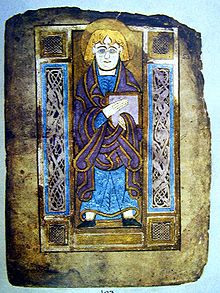Book of Mulling
The Book of Mulling is a small format gospel book that is kept in the library of Trinity College in Dublin , Ireland, and has the signature IE TCD MS 60. It is a major work of insular book illumination from the second half of the 8th century. The parchment leaves of the manuscript are now separated from one another. They have the dimensions 165 mm × 120 mm.
Surname
The Gospels got its name from the fact that it was previously believed to have been written by St. Moling († 697), a saint from Leinster . This is how the colophon was understood at the end of the Gospel of John: “[N] omen scriptori Mulling dicitur. (The scribe's name is Mulling.) “The gospel book may be a copy of an autograph by St. Moling.
content
Apart from the text of the Gospels, the manuscript contains prefaces and canon tables and an incomplete liturgy for the visiting of the sick (missa de infirmis), consisting of 13 Latin prayers with some Irish words.
history
It is believed that the book was made in Tech-Moling Monastery (now St. Mullins) in Ireland.
The preserved shrine of this book was commissioned in 1402 by Art MacMurrough Kavanagh. In the 18th century, the Book of Mullin was owned by the Kavanagh family; At the end of the 18th century, the book and shrine were given to Trinity College. The Gospels stayed here, while the shrine returned to the Kavanagh family at the end of the 19th century and was later given on permanent loan to the National Museum of Ireland in Dublin.
In 1977 the Book of Mullins was rebound; until then, all miniatures had been included at the end of the manuscript. When assigning the evangelists to the beginning of the respective gospels, a color comparison between the figure and the incipit was based .
Work of calligraphers
Three scribes were involved, one of whom wrote the Forewords, one the Synoptic Gospels and one the Gospel of John . The script is a fine Irish minuscule .
Work of illustrators
The manuscript is decorated on the one hand with initials and on the other hand with portraits of evangelists, three of which have survived; they are identified as Matthew , Mark and John . The assignment is not clear because the evangelist symbols are missing. All three are depicted as young men with a halo , facing the viewer frontally and with their gospel book in their hands. The evangelist, identified today with Matthew, can be seen as a scribe, as he is just dipping the pen into the inkwell.
The book also contains drawings of two circles and twelve crosses with Irish inscriptions. It used to be seen as an ideal plan of St. Mullins Monastery, today it is understood as an illustration of the prayer text on the opposite page.
literature
- Charles Doherty: Book of Mulling . In: Lexicon of the Middle Ages (LexMA). Volume 2, Artemis & Winkler, Munich / Zurich 1983, ISBN 3-7608-8902-6 , Sp. 442.
Web links
- Trinity College Library: Book of Mulling digitized version ( here also information on the manuscript )
- Trinity College Library: The Early Irish Manuscripts Project
- Book of Mulling . Publications in the bibliographic database of the Regesta Imperii .

